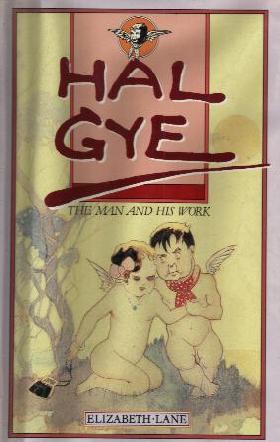|
Dustjacket synopsis:
"When C.J. Dennis's The Songs of a Sentimental Bloke was published in 1915, its instant, phenomenal popularity shot
the author to fame and fortune. But what of Dennis's little-known collaborator, Hal Gye, the whimsical creator of the
naked, winged cupids that adorn Dennis's poem of a Melbourne larrikin and his factory girl?
"In Hal Gye: The Man and his Work, Elizabeth Lane tells the story of that most successful collaboration in
Australian literary history. Her story, which begins when she makes the acquaintance of Gye in 1947 through a gap in the
palings of their common dividing fence, is based on Gye's reminiscences - related to her over the twenty years that they
were neighbours - and traces his life until his death in 1967.
"Cartoonist, illustrator of books by Lawson, Paterson and Ogilvie, painter of works held in several State art galleries,
Gye's artistic output represented only part of his talents. Under the pseudonym of James Hackson he also wrote short
stories which, in their tragicomic evocation of the English settler and his family battling the heat and dust of the
Australian countryside, have found a lasting place in the annals of the best short-story writing in Australia.
"This volume is not only an affectionate and absorbing memoir of a multi-talented man, but also contains the best of Hal
Gye - a selection of his full-colour illustrations of various works by C. J. Dennis, black-and-white line drawings,
photographs, Gye's own account of his early years and a selection of his short stories."
Contents:
Introduction
The Hole in the Bedroom Floor - Hal Gye's own account of his early years
A Personal memoir
A Selection of Stories from Father Clears Out
First Paragraph from the Introduction:
I first met Mr Hal Gye through a gap in the palings of our dividing side fence. A sagging-at-the-knees, ragged old fence
that would have flopped years before had it not been held together by a large-leafed, creeping ivy that had, over the years,
not only forced its way from the backyard to the front, but had sprouted an upright mass of growth that towered
belligerently above the whole length of the fence, as if daring it to fall down.
It was late September 1947, and we had only that week moved into the house at 16 Hampden Road, Armadale,
Victoria. On this day I'd gone out to begin gardening in the backyard. Because we were just coming out of a cold, wet
Melbourne winter, and I was on the shady side of the fence, I started where there was a patch of sun streaking through the
broken paling.
No sooner had I knelt to my weeding than the splash of sunlight suddenly disappeared. A moment later it was there
again. After this had happened several times, I edged closer to the fence and put my eye to the gap. There I saw a trim,
not very tall, middle-aged man on the other side of the fence.
First Paragraph from Hal Gye's memoir:
My father said I was so smart I would see the four walls of a jail before I was twenty-one; but I did not come up to his
expectations.
I remember most distinctly being wheeled in a perambulator by a boy with a shanghai. I didn't know it was a
shanghai then; but I took stock of the shape of it hanging out of the boy's pocket. Then a passing boy grabbed the
shanghai and ran off with it, and my young guardian set off after him, and I, turning round in the pram, noticed my
guardian's thin, black-stockinged legs.
And I was a sensitive little bloke for I also, remember, as clearly as if it were yesterday, how I kicked and screamed to
get away from a woman in a velvet dress of faded purple and to this day I cannot stand the touch of velvet - not faded
purple velvet; but I've given up the kicking and the screaming.
Colour attracted me and when a Lucy Whittle, who lived in the house beside the heap of horse-dung and the two dead
cats, came and stood in front of our picket fence and showed me her new green drawers it was a wonder my eyes did not
shoot out of their sockets; more so when I saw her navel winking at me. Since then, new green drawers have always reminded
me of Lucy Whittle's navel winking at me.
From the Angus & Robertson hardback edition, 1986.
|
